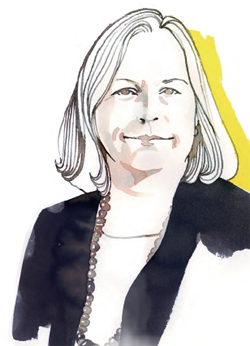Q+A with Catherine Lord
An autism expert moves from diagnosis to “what happens next”.

“My goal is nothing short of transforming the way autism is treated,” says Catherine Lord, PhD ’76, who has arguably done more than anyone to shape our current understanding of how to diagnose and evaluate the disorder. The author of more than 160 peer-reviewed papers and nine books, she led the development of the Autism Diagnostic Observation Schedule and the Autism Diagnostic Interview, international benchmarks for the early identification of children on the autism spectrum. In May 2011, she announced that she was leaving the University of Michigan’s Autism and Communication Disorders Center, which she had directed for almost ten years, to head New York-Presbyterian Hospital’s new Center for Autism and the Developing Brain. An innovative clinical and research facility developed with the medical schools of Columbia and Cornell, and initiated at the impetus of a parent-led nonprofit, the Center is scheduled to open this March. She is currently serving on the panel of researchers revising the definition of the disorder for a new version of the all-important Diagnostic and Statistical Manual, DSM-5, to be published by the American Psychiatric Association next May.
Are we seeing an “epidemic” of autism, as many claimed last spring when the Centers for Disease Control estimated that 1 in 88 American children has some form of the disorder?
References to “epidemic” are probably too strong. Whether or not there are more children with autism now than years ago is a real question. What is clear is that the definition has broadened, awareness has increased radically, and we’re identifying more children younger. What’s also clear is that if the United States does things right and we get better services for everybody, the numbers are only going to grow: we know that currently, kids of ethnic minorities are identified later and less likely to be identified. It’s important to note that, even with all these explanations, they still don’t seem to be enough to account for the huge increases, which seem pretty consistent across North America, Europe, Australia, Japan, and Korea. But I worry about the word “epidemic,” which implies something contagious, which autism is not.
Will explaining autism’s prevalence be a goal of the Center?
Well, only indirectly. We want to figure out what are the core symptoms of autism, what differentiates it from other disorders, and what are reliable, valid, and efficient ways to identify kids with autism. Then, we want to figure out how their behavior changes over time, both in response to treatment and also naturally. So that has implications for the measurement of prevalence, as we move toward a more accurate characterization of autism.
What is your response to critics who claim that the DSM-5’s redefinition of autism is too restrictive?
I don’t think it’s true. We’re all stuck at this point looking at old data and trying to match it up with new ideas. We just had a paper come out using three large data sets, finding that DSM-5 was a much better fit than suggested by older studies that had used smaller data sets. We are being more restrictive in terms of the principles that define autism, but we’re also being more expansive in terms of the symptoms associated with those principles. The very reason we rewrote the definition is to expand recognition that autism exists in adults, it exists in toddlers, it exists in girls.
How early can we now diagnose autism?
It’s very hard to diagnose autism in children who aren’t walking, because social behavior changes once you can walk. Even crawling isn’t the same as being able to walk with your head up, looking at people or not looking at people, carrying things. Maybe eventually we’ll have biomarkers, or tasks just involving looking at pictures. But right now, we really can’t tell for sure until about twelve months. And I think even twelve months is really hard; it is important to get started in some treatment if we are worried about very young children, but we need to be humble about the reliability of these very early diagnoses.
What led you to autism research?
I was an undergraduate at UCLA when Ivar Lovaas got the idea that with behavioral principles maybe we could teach children with autism, who he thought just weren’t socially motivated, to seek out people and to learn to approach people and to talk. Back in those days of early behaviorism, the idea was that kids were blank slates, and somehow children with autism had just missed the idea of social motivation, and we could teach it to them. So I was part of an army of undergraduates working with kids brought out of institutions. When I went to graduate school, I became more interested in cognitive development, and wanted to focus on how this happens. I was struck by the mystery of it all.
What will set the new Center apart from similar institutions?
We’ve decided that we want to focus on moving from diagnosis, assessment, and evaluation to treatment and working with the community. It was really sort of fortuitous that I got into diagnosis and assessment at all — it was not because they were what I was really interested in. I was interested in looking at development and how things change, but you can’t do that if you can’t measure things and get others to agree on whom you are talking about. Then, after the first instruments were developed, there was a time in my life where I had to say “Look, I’m going to go insane if these tools aren’t standardized, and if I don’t really work on them nobody else will.” So we’ve been able to do informative and family-friendly assessments for a long time, but now it’s time to ask how we can we move ahead and focus on what happens next.
Here in New York, we have a clear clinical mandate, because our funds were raised by the nonprofit organization New York Collaborates for Autism, and this group was founded by parents and people who have a very vested interest in autism. So we have the opportunity to set up the best clinical services possible. In addition to offering a whole repertoire of different treatment options, then, we’ll be working with parents, families, and communities to make those treatments as effective as possible.
Talk about promising treatment methods you’re exploring
We’re very interested in building on evidence-based treatments that have scientific data to support them, but also recognizing that children and adults with ASD are unique, as are their families, and we need to create individualized plans that build on strengths and weaknesses, work with what is available in communities, and recognize that there may be multiple ways to accomplish a goal. We are very interested in using the Early Start Denver Model with young children, as well as aspects of the Early Social Interaction parent-oriented program, Pivotal Response Training, and various approaches to applied behavior analysis. We are also interested in combining direct treatments such as cognitive behavioral therapy with community-based social networks and parent involvement.
How will the Center’s physical layout help your work?
We’re going to be housed in an old, historic gymnasium, and the outside won’t look any different than it has for a hundred years. On the inside, though, will be a little “village” within this towering, high-ceilinged structure. We want kids to be able to move around the village, but also to know which room is theirs: each room will have its own little roof, and you enter them from little streets. The buildings have different roof heights, they’re different colors, and there’s a lot of glass, so parents can sit and watch their children, and trainees can easily observe what we do.
Will the Center help with the transition into adulthood?
Absolutely. You’re an adult a lot longer than you’re a kid. In the last 20 years, the level of education of students with autism has increased tremendously, but the level of independent employment has not increased that much. And while there are vocational programs, they’re much more focused on getting students into a job than helping them learn what to do when they’re in the job. So before we’ve even opened, we’ve started a supported employment program with some important collaborators, where students in the last year of high school meet with a vocational teacher and attend classes in the morning and then go off and work in various locations all around New York-Presbyterian Hospital for three-month rotations. The idea is to really put them to work, and I’ve been really impressed with the degree to which the hospital staff has welcomed them there and really got them started.
What still needs to change in society’s understanding of autism?
We need better funding for medical services. It’s ridiculous that insurance still treats autism so differently from, you know, a torn ligament or back pain. That’s one bottom line. Intentions and fairness of treatment in education are much better than in health, but education is just a small part of your life. And in education, we still need to figure out how to address the individual needs of the students. We go back and forth between fads of pulling the kids out for one-on-one, and then putting them back in the classroom, and then having someone follow them around in that classroom – so that’s another thing. Trying to figure out how to provide the least restrictive environment, but still provide adequate teaching and support.
Illustration by Tina Berning
Get the Latest Updates
Join Our Newsletter
Subscribe to Colloquy Podcast
Simplecast





